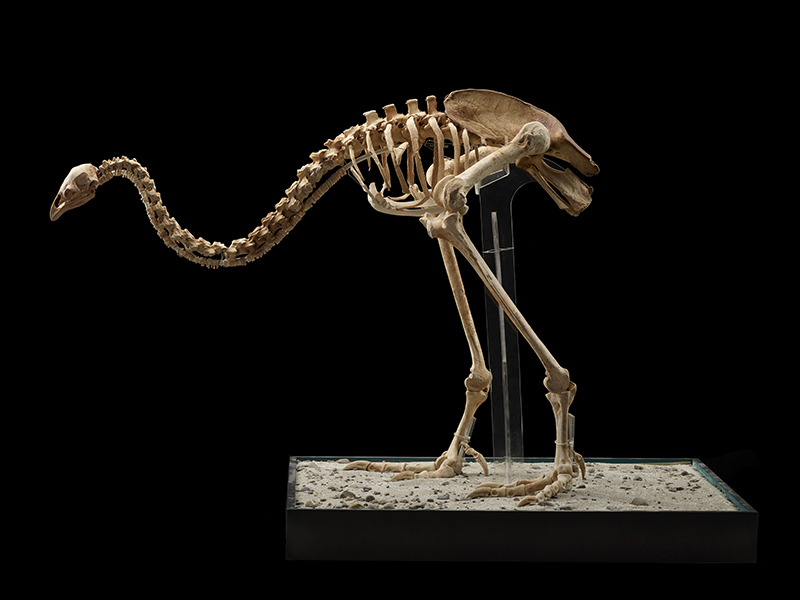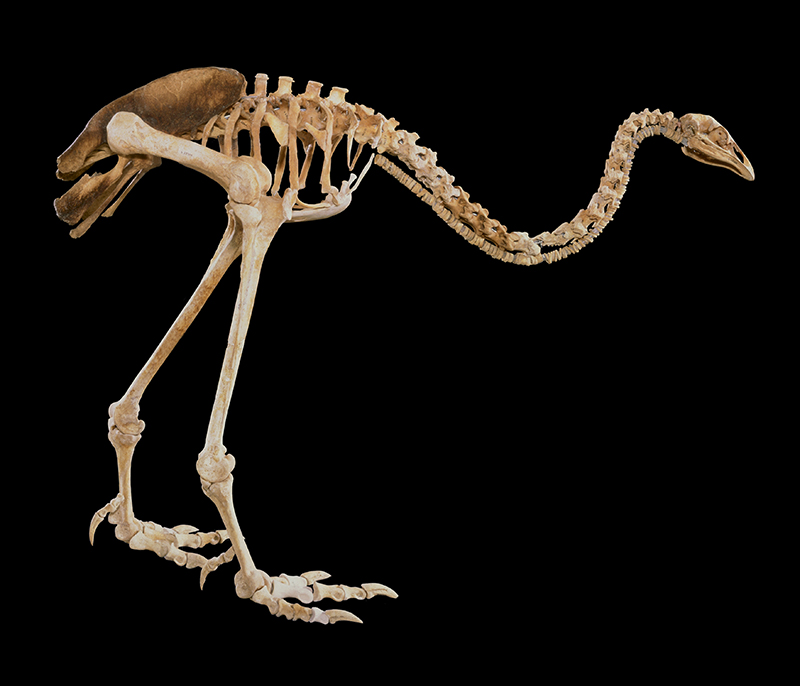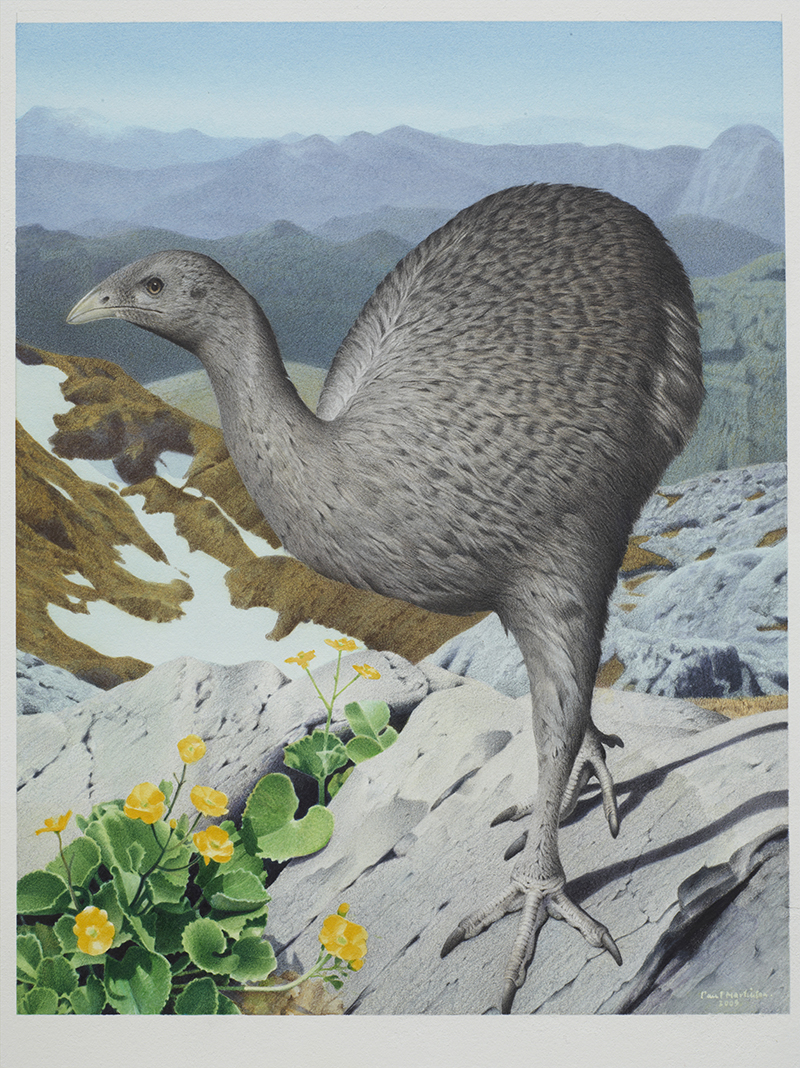Megalapteryx didinus (Owen, 1883:257)
Upland moa, Lesser megalapteryx, South Island tokoweka , "Bush" moa, Moa Pukepuke (Māori)
Taxonomy & Nomenclature
Synonyms: Dinornis didinus Owen, 1882:549 [nomen nudum]; Dinornis didinus Owen, 1883:257; Anomalopteryx didina (Owen, 1883:257); Megalapteryx didinus (Owen, 1883:257); Megalaperyx didinus (Owen, 1883:257) [orth. error used by WCMC, 1992:211]; Megalapteryx hectori Haast, 1884:577 [nomen nudum]; Megalapteryx hectori Haast, 1886a:541 [nomen nudum]; Megalapteryx hectori Haast, 1886b:162; Megalapteryx tenuipes Lydekker, 1891:251; Megalapteryx hamiltoni Rothschild, 1907:197; Palaeocasuarius haasti Rothschild, 1907:220; Palaeocasuarius velox Rothschild, 1907:220; Palaeocasuarius elegans Rothschild, 1907:220; Megalapteryx benhami Archey, 1941:35
A complete synonymy taken from (Checklist Committee (OSNZ), 2022:14):
Dinornis didinus Owen, 1882 (Oct.): Proc. Zool. Soc. London 1882 (36): 549 [nomen nudum]; Dinornis didinus Owen, 1883: Trans. Zool. Soc. London 11(8): 257 – Queenstown; Anomalopteryx didina (Owen); Lydekker 1891, Cat. Fossil Birds Brit. Museum: 277; Megalapteryx didinus (Owen); Oliver 1930, New Zealand Birds, 1st edition: 42; Megalapteryx hectori Haast, 1884: Trans. N.Z. Inst. 16: 577 [nomen nudum]; Megalapteryx hectori Haast, 1886a: Proc. Zool. Soc. London 1885 (35): 541 [nomen nudum]; Megalapteryx hectori Haast, 1886b: Trans. Zool. Soc. London 12(5): 162 – Takaka, Nelson; Megalapteryx tenuipes Lydekker, 1891: Cat. Fossil Birds Brit. Museum: 251 – Lake Wakatipu; Megalapteryx tenuipes Lydekker; Andrews 1897, Novit. Zool. 4: 188; Megalapteryx hamiltoni Rothschild, 1907: Extinct Birds: 197 – “Waingongoro, North Island”, error (fide Oliver 1949, Dom. Mus. Bull. 15: 151); Palaeocasuarius haasti Rothschild, 1907: Extinct Birds: 220 – Maniototo, Otago; Palaeocasuarius velox Rothschild, 1907: Extinct Birds: 220 – Maniototo, Otago; Palaeocasuarius elegans Rothschild, 1907: Extinct Birds: 220 – Maniototo, Otago; Megalapteryx benhami Archey, 1941: Bull. Auck. Inst. Museum 1: 35 – Mt Arthur [Salisbury] Tableland, Nelson
Conservation Status
Extinct (WCMC, 1992:211)
Last record: 694±30 yrs BP (663-559 cal. BP) (Wood et al., 2012); 1785 (WCMC, 1992:211)
Distribution
South Island, New Zealand
Biology & Ecology
Hypodigm
Media

Above: Upland Moa, Megalapteryx didinus, collected March 1987, Honeycomb Hill, Enduro, Map Grid 1385N 720E, New Zealand. Field Collection 1982-1988. CC BY 4.0. Te Papa (S.023700)

Above: Upland Moa, Megalapteryx didinus, collected March 1987, Honeycomb Hill, Enduro, Map Grid 1385N 720E, New Zealand. Field Collection 1982-1988. CC BY 4.0. Te Papa (S.023700)

Above: Upland Moa. Megalapteryx didinus. From the series: Extinct Birds of New Zealand., 2005, Masterton, by Paul Martinson. Purchased 2006. © Te Papa. CC BY-NC-ND 4.0. Te Papa (2006-0010-1/16)
References
Original scientific description:
Owen, Richard. (1883). On Dinornis (Part XXIV): containing a description of the head and feet, with their dried integuments, of an individual of the species Dinornis didinus, Owen. Transactions of the Zoological Society of London 11: 257-261.
Other references:
Anderson, A. J. (1983). Faunal depletion and subsistence change in the early prehistory of southern New Zealand. Archaeology in Oceania 18: 1-10.
Anderson, Atholl. (1989a). Prodigious Birds. Moas and Moa-Hunting in New Zealand. Cambridge University Press. 238 pp.
Anderson, Atholl. (1989b). On evidence for the survival of moa in European Fiordland. New Zealand Journal of Ecology 12(supplement): 39-44.
Andrews, C. W. (1897). On a Complete Skeleton of Megalapteryx tenuipes Lyd. in the Tring Museum. Novit. Zoolog. 4: 188-194.
Anonymous. (1971). Giant birds striding. New Zealand's Heritage 1: 7-11.
Attard, M. R. G., Wilson, L. A. B., Worthy, T. H., Scofield, P., Johnston, P., Parr, W. C. H. and Wroe, S. (2016). Moa diet fits the bill: virtual reconstruction incorporating mummified remains and prediction of biomechanical performance in avian giants. Proc. R. Soc. B 283: 20152043.
Baker, Allan J. et al. (2005). Reconstructing the tempo and mode of evolution in an extinct clade of birds with ancient DNA: The giant moas of New Zealand. PNAS 102(23): 8257-8262.
Begg, A. C. and Begg, N. C. (1979). The world of John Boultbee. Christchurch: Whitcoulls.
Blencowe, Michael. (2021). Gone: A search for what remains of the world's extinct creatures. Leaping Hare Press. 192 pp.
Blencowe, Michael. (2022). Gone: Stories of Extinction. Aurum. 208 pp.
Checklist Committee (OSNZ). (2010). Checklist of the Birds of New Zealand, Norfolk and Macquarie Islands, and the Ross Dependency, Antarctica (4th ed.). Ornithological Society of New Zealand & Te Papa Press, Wellington. [p. 12-13]
Checklist Committee (OSNZ). (2022). Checklist of the Birds of New Zealand (5th edition). Ornithological Society of New Zealand Occasional Publication No. 1. Wellington: Ornithological Society of New Zealand. [p. 14-15]
Cooper, Alan et al. (2001). Complete mitochondrial genome sequences of two extinct moas clarify ratite evolution. Nature 409(6821): 704-707.
Cracraft, J. (1976). Journal of morphology, 150(2), 495-526.
Duff, Roger. (1952). Recent Maori occupation of Notornis Valley, Te Anau. The Journal of the Polynesian Society 61(1-2): 90-119. ["followed in late 1949 by the discovery in the same valley of evidence that recent Maori visitors—possibly in the post-European period—had encountered and killed a single individual of Megalapteryx didinus, the small forest-dwelling moa" (p. 90)]
Duff, Roger. (1956). The moa-hunter period of Maori culture. Government Printer, Wellington.
Falla, R. A. (1962). The moa, zoological and archaeological. Newsletter of the New Zealand Archaeological Association 5: 189-191.
Falla, R. A. (1974). The moa. New Zealand's Nature Heritage 1: 69-74.
Fuller, Errol. (1988). Extinct Birds. New York: Facts on File Publications. 256 pp.
Haast, J. (1884). On the leg bones of a new species of kiwi (Megalapteryx hectori). Transactions and Proceedings of the New Zealand Institute 16, 576-577.
Haast, J. (1886a). Preliminary notice of paper on Megalapteryx hectori. P. Zool. Soc. Lond. for 1885, III, 541.
Haast, J. (1886b). On Megalapteryx hectori, a new gigantic species of apterygian bird. Transactions of the Zoological Society of London 12: 161-169.
Hall-Jones, John. (1960). Rare Fiordland birds. Notornis 8(7): 191-192.
Hall-Jones, John. (1976). Fiordland Explored. Wellington: Reed.
Heuvelmans, Bernard. (1955). Sur la Piste des Bêtes Ignorées. Le tome 1. Indo-Malaisie, d’ Océanie. Paris: Librairie Plon.
Heuvelmans, Bernard. (1958). On the Track of Unknown Animals (translated by Richard Garnett). London: Rupert Hart-Davis / New York: Hill and Wang.
Heuvelmans, Bernard. (1982). Sur la Piste des Bêtes Ignorées. Le tome 1. Indo-Malaisie, d’ Océanie. Paris: François Beauval / Geneva: Famot.
Heuvelmans, Bernard. (1986). Annotated checklist of apparently unknown animals with which cryptozoology is concerned. Cryptozoology 5: 1-26.
Holdaway, Richard N., Worthy, Trevor H. and Tennyson, Alan J. D. (2001). A working list of breeding bird species of the New Zealand region at first human contact. New Zealand Journal of Zoology 28: 119-187.
Hume, Julian Pender and Walters, Michael. (2012). Extinct Birds. London: T & AD Poyser.
Knox, Alan G. and Walters, Michael P. (1994). Extinct and endangered birds in the collections of The Natural History Museum. British Ornithologists' Club Occasional Publications 1: 1-292. [p. 277]
Lockley, R. M. (1970). Man against nature. London: Andre Deutsch.
Lydekker, Richard. (1891). Catalogue of the fossil birds in the British Museum (Natural History). London: British Museum Publishers. 368 pp.
Mackal, Roy P. (1980). Searching for Hidden Animals: An Inquiry into Zoological Mysteries. New York: Doubleday.
Oliver, W. R. B. (1949). The moas of New Zealand and Australia. Dominion Museum Bulletin 15: 1-206.
Rawlence, Nicolas J. et al. (2009). DNA content and distribution in ancient feathers and potential to reconstruct the plumage of extinct avian taxa. Proceedings of the Royal Society, B 276(1672): 3395-3402.
Rawlence, N. J., Wood, J. R., Scofield, R. P., Fraser, C. and Tennyson, Alan J. D. (2012). Soft-tissue specimens from pre-European extinct birds of New Zealand. Journal of the Royal Society of New Zealand iFirst 2012: 1-28.
Richards, R. (1986). Which pakeha ate the last moa? Paremata: Paremata Press.
Robertson, H. A., Baird, K. A., Elliott, G. P., Hitchmough, R. A., McArthur, N. J., Makan, T. D., Miskelly, Colin M., O’Donnell, C. F. J., Sagar, P. M., Scofield, R. P., Taylor, G. A. and Michel, P. (2021). Conservation status of birds in Aotearoa New Zealand, 2021. New Zealand Threat Classification Series 36. Department of Conservation, Wellington. 43 pp.
Sayol, Ferran, Steinbauer, Manuel J., Blackburn, Tim M., Antonelli, Alexandre and Faurby, Søren. (2020). Anthropogenic extinctions conceal widespread evolution of flightlessness in birds. Science Advances 6(49): eabb6095. https://doi.org/10.1126/sciadv.abb6095 [Supplementary Material (Data File S1)]
Scarlett, Ron J. (1972). Bones for the New Zealand Archaeologist. Christchurch: Canterbury Museum. 64 pp.
Seersholm, Frederik V. et al. (2018). Subsistence practices, past biodiversity, and anthropogenic impacts revealed by New Zealand-wide ancient DNA survey. PNAS. https://doi.org/10.1073/pnas.1803573115 [Supplementary information]
Tennyson AJD and Martinson P (2006) Extinct Birds of New Zealand. Te Papa Press, Wellington.
Thomson, A.S. 1859. The story of New Zealand. John Murray, London. 2 vols.
Trotter, M. M. (1965). Avian remains from North Otago archaeological sites. Notornis 12(3): 176-178.
Tyrberg, Tommy. (2009). Holocene avian extinctions, pp. 63-106. In: Turvey, Samuel T. (ed.). Holocene Extinctions. Oxford, UK & New York, USA: Oxford University Press. xii + 352 pp.
Vickers-Rich, P., Trusler, P., Rowley ,M.J., Cooper, A., Chambers, G.K., Bock, W.J., Millener, P.R., Worthy, T.H., Yaldwyn, J.C., (1995). Morphology, myology, collagen and DNA of a mummified moa, Megalapteryx didinus (Aves: Dinornithiformes) from New Zealand. Tuhinga: Records of the Museum of New Zealand Te Papa Tongarewa 4: 1-26.
Vickers-Rich, P., P. Trusler, J. Yaldwyn, M. Rowley, P.R. Millener, A. Cooper, G. Chambers, W. Bock, T. Worthy & A. Anderson. 1989. A mummy of the upland moa, Megalapteryx didinus, from South Island, New Zealand, 1989. Conf. Aust. Vert. Palaeo. Evol., Sydney, March, 1989.
WCMC (World Conservation Monitoring Centre). (1992). Global Biodiversity: Status of the Earth's living resources. London: Chapman & Hall. xx + 594 pp.
Wood, Jamie R., Rawlence, Nicolas J., Rogers, Geoffrey M., Austin, Jeremy J., Worthy, Trevor H. and Cooper, Alan. (2008). Coprolite deposits reveal the diet and ecology of the extinct New Zealand megaherbivore moa (Aves, Dinornithiformes). Quaternary Science Reviews 27(27-28): 2593-2602.
Wood, Jamie R. (2009). Two Late Quaternary avifaunal assemblages from the Dunback district, eastern Otago, South Island, New Zealand. Notornis 56: 154-157.
Wood, Jamie R. et al. (2012). High-Resolution Coproecology: Using Coprolites to Reconstruct the Habits and Habitats of New Zealand’s Extinct Upland Moa (Megalapteryx didinus). PLoS ONE 7(6): e40025.
Wood, Jamie R., Wilmshurst, J. M., Rawlence, N. J., Bonner, K. I., Worthy, Trevor H. et al. (2013). A Megafauna’s Microfauna: Gastrointestinal Parasites of New Zealand’s Extinct Moa (Aves: Dinornithiformes). PLoS ONE 8(2): e57315.
Wood, J. R., Janet M. Wilmshurst, Sarah J. Richardson, Nicolas J. Rawlence, Steven J. Wagstaff, Trevor H. Worthy and Alan Cooper. (2013). Resolving lost herbivore community structure usingcoprolites of four sympatric moa species (Aves: Dinornithiformes). Proceedings of the National Academy of Sciences of the United States of America 110(42): 16910-16915.
Worthy, Trevor H. (1988). A re-examination of the moa genus Megalapteryx. Notornis 35(2): 99-108.
Worthy, Trevor H. (1989). Moas of the subalpine zone. Notornis 36: 191-196.
Worthy, Trevor H. (1990). An analysis of the distribution and relative abundance of moa species (Aves: Dinornithiformes). New Zealand Journal of Zoology 17: 213-241.
Worthy, Trevor H. (1991). An overview of the taxonomy, fossil history, biology and extinction of moas. Proceedings of the Twentieth International Ornithologists Congress, Symposium 6: 555-562.
Worthy, Trevor H. (1993). Fossils of Honeycomb Hill. Museum of New Zealand, Te Papa Tongarewa, Wellington. 56 pp.
Worthy, Trevor H. (1994). Late Quaternary changes in the moa fauna (Aves; Dinornithiformes) on the West Coast of the South Island, New Zealand. Rec. S. Aust. Mus. 27(2): 125-134.
Worthy, Trevor H. (1997). Fossil deposits in the Hodges Creek Cave System, on the northern foothills of Mt Arthur, Nelson, South Island, New Zealand. Notornis 44(2): 111-124.
Worthy, Trevor H. (1998). Quaternary fossil faunas of Otago, South Island, New Zealand. Journal of the Royal Society of New Zealand 28(3): 421-521. https://doi.org/10.1080/03014223.1998.9517573 [p. 450]
Worthy, Trevor H. and Holdaway, Richard N. (1993). Quaternary fossil faunas from caves in the Punakaiki area, West Coast, South Island, New Zealand. Journal of the Royal Society of New Zealand 23(3): 147-254.
Worthy TH and Holdaway RN (2002) The Lost World of the Moa. Indiana University Press, Bloomington.
Worthy, Trevor H. and Zhao, J. X. (2006). A late Pleistocene predator-accumulated avifauna from Kids Cave, West Coast, South Island, New Zealand. Alcheringa Special Issue 1: 389-408.
Wragg, Graham M. (1981). The birds of Canterbury: history and present status. A dissertation presented as a requirement for the Diploma in Parks and Recreation (National Parks option). Lincoln College, New Zealand.
